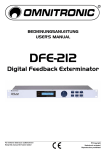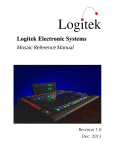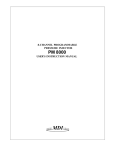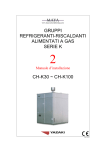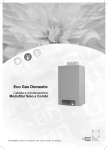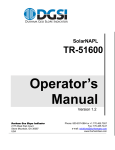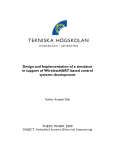Download DAPAudio Xtreme X-2000 Product guide
Transcript
DF-12 ORDERCODE D2060 Congratulations! You have bought a great, innovative product from DAP Audio. The DAP Audio DF-12 brings excitement to any venue. Whether you want simple plug-&-play action or a sophisticated show, this product provides the effect you need. You can rely on DAP Audio, for more excellent audio products. We design and manufacture professional audio equipment for the entertainment industry. New products are being launched regularly. We work hard to keep you, our customer, satisfied. For more information: [email protected] You can get some of the best quality, best priced products on the market from DAP Audio. So next time, turn to DAP Audio for more great audio equipment. Always get the best -- with DAP Audio ! Thank you! DAP Audio DAP Audio DF-12 Product Guide Warning..…...................................................................................………………………………………….. Safety-instructions………………………………………………………………………………………….…. Operating Determinations……………………………………………………………………………………. 2 2 3 Description..…..............................................................................……….………………………………… Features………………………………………………………………………………….………………….…. Overview Front side..…………………………………………………………………………………....……. Overview Back side..…………………………………………………………………………………….……. 4 4 4 5 Installation..................................................................……………………………..………………………… 6 Set Up and Operation.....................................................................……..…………………………….…… Menu Functions………..………………………………………………………………………..……….……. MIDI..……….……...……….…….……….……..……….……..……….……..……….……..……….…..…. 6 7 9 Frequency Chart..................................................................……………………………..…………………. 10 Preset Table..................................................................……………………………..…………………….… 11 Connection Cables..............................….......................................………..………….…….………….….. 12 Maintenance………..............................….......................................………..………….…….………….….. Replacing the Fuse........................................................................…………………….………………… 13 13 Troubleshooting………..............................…................................………..………….…….………….….. 13 Product Specifications.................................................................……………….…….………………….. 14 1 WARNING CAUTION! Keep this system away from rain and moisture! FOR YOUR OWN SAFETY, PLEASE READ THIS USER MANUAL CAREFULLY BEFORE YOUR INITIAL START-UP! SAFETY INSTRUCTIONS Every person involved with the installation, operation and maintenance of this system has to: be qualified follow the instructions of this manual CAUTION! Be careful with your operations. With a dangerous voltage you can suffer a dangerous electric shock when touching the wires! Before you initial start-up, please make sure that there is no damage caused by transportation. Should there be any, consult your dealer and do not use the system. To maintain perfect condition and to ensure a safe operation, it is absolutely necessary for the user to follow the safety instructions and warning notes written in this manual. Please consider that damages caused by manual modifications to the system are not subject to warranty. This system contains no user-serviceable parts. Refer servicing to qualified technicians only. IMPORTANT: The manufacturer will not accept liability for any resulting damages caused by the non-observance of this manual or any unauthorized modification to the system. • • • • • • • • • • • • • • • • Never let the power-cord come into contact with other cables! Handle the power-cord and all connections with the mains with particular caution! Never remove warning or informative labels from the unit. Never use anything to cover the ground contact. Do not insert objects into air vents. Do not connect this system to a dimmerpack. Do not switch the system on and off in short intervals, as this would reduce the system’s life. Do not open this device. Risk: hazardous radiation exposure. Do not run the output of any amplifier channel, back into another channel’s input. Do not connect (parallel or series) an amplifier output with any other amplifier output. Only use system indoor, avoid contact with water or other liquids. Avoid flames and do not put close to flammable liquids or gases. Always disconnect power from the mains, when system is not used. Only handle the power-cord by the plug. Never pull out the plug by tugging the power-cord. Make sure you don’t use the wrong kind of cables or defective cables. Make sure that the signals into the mixer are balanced, otherwise hum could be created. Make sure you use DI boxes to balance unbalanced signals; All incoming signals should be clear. Make sure that the available voltage is not higher than stated on the rear panel. 2 • • • • • • • • • • • • • • • • • Make sure that the power-cord is never crimped or damaged. Check the system and the power-cord from time to time. Always operate the unit with the AC ground wire connected to the electrical system ground. Connecting amplifier outputs to oscilloscopes or other test equipment, while the amplifier is in bridged mode, may damage both the amplifier and test equipment. Do not drive the inputs with a signal level bigger, than required to drive the equipment to full output. In system setup, the amplifier's output power must be 50%-100% more than the loaded loudspeakers rated power. Please turn off the power switch, when changing the power cord or signal cable, or select the input mode switch. In typical use, Please set the volume to 0dB position. Sometimes, when you want to send one signal to more than one amplifier, you should use a signal distributor. Extreme frequency boosts in connection with a high input signal level may lead to overdriving your equipment. Should this occur, it is necessary to reduce the input signal level by using the INPUT control. To emphasize a frequency range, you don’t necessarily have to move its respective sliding control upward; try lowering surrounding frequency ranges instead. This way, you avoid causing the next piece of equipment in your sound path to overdrive. You also preserve valuable dynamic reserve (“headroom”) For replacement use fuses of same type and rating only. Prevent distortion! Make sure that all components connected to the DF-12 have sufficient power ratings. Otherwise distortion will be generated because the components are operated at their limits. Avoid ground loops! Always be sure to connect the power amps and the mixing console to the same electrical circuit to ensure the same phase! If system is dropped or struck, disconnect mains power supply immediately. Have a qualified engineer inspect for safety before operating. If the system has been exposed to drastic temperature fluctuation (e.g. after transportation), do not switch it on immediately. The arising condensation water might damage your system. Leave the system switched off until it has reached room temperature. Repairs, servicing and electric connection must be carried out by a qualified technician. WARRANTY: Till one year after date of purchase. OPERATING DETERMINATIONS If this system is operated in any other way, than the one described in this manual, the product may suffer damages and the warranty becomes void. Any other operation may lead to dangers like short-circuit, burns, electric shock, etc. You endanger your own safety and the safety of others! Improper installation can cause serious damage to people and property ! 3 Description of the device Features The DF-12 is a professional Feedback Eliminator: • The DF-12 effectively avoids any occurring feedbacks in your amplifying system • 4 different Monitor Modes: OFF, Parametric EQ, Auto Mode, Vocal Mode. • 12 automatically controlled feedback frequencies per channel • Connection via balanced XLR-sockets or jacks • Total real-time MIDI control • 16 x 2 backlight LCD Display Overview Fig. 1 1) LCD Display 2) Parameter / Push Jogwheel: Adjust the parameters 3) Filter Mode 4) CH R / Couple 5) Store / MIDI 6) Filter / SEL: Sequence & Filter button. Press once to enter Filter (12 filters) and twice to enter Sequence (10 Channels) 7) CH L 8) Bypass: This button allows you to instantly compare the original sound (Display shows BYP) with the equalized sound (Display shows GEQ) 9) Power Switch 4 Fig. 2 DF-12 DESCRIPTION REAR PANEL: 10) IEC Connector + Fuse 11) AC Voltage Selector 115V/230V 12) Midi Out 13) Midi Thru 14) Midi In 15) XLR Output 2 16) TRS Output 2 17) Input Level –20dB / + 4dB 18) TRS Input 2 19) XLR Input 2 20) TRS Output 1 21) XLR Output 1 22) Input Level –20dB / + 4dB 23) TRS Input 1 24) XLR Input 1 Fig. 3 25) Clip LED: for Left / Right Input / Output indication 26) P: indicates the Program. You can select between P1 - P10. 27) CH: Adjust the Left / Right Channel 28) EQ: EQ-On means all filters are on; EQ-off means Auto & single are not affected; BYPA means all filter effects are not functioning because you are in Bypass mode. 29) FILT: indicates the Filter. You can select between FILT1 – FILT12 30) PEQ: 4 Available modes: OFF, PEQ (parametric EQ), AUTO and SING (single) 31) SV: This reminds the user that the editable parameters are ready to be saved and stored in the memory, by blinking slowly every 2 seconds. Press the STORE-button once and it will blink every second. If you press the STORE-button again, the SV indication in the display will disappear. 5 Installation Remove all packing materials from the DF-12. Check that all foam and plastic padding is removed. Screw the equipment into a 19" rack. Connect all cables. Always disconnect from electric mains power supply before cleaning or servicing. Damages caused by non-observance are not subject to warranty. Set Up and Operation Before plugging the unit in, always make sure that the power supply matches the product specification voltage. Do not attempt to operate a 120V specification product on 240V power, or vice versa. Install this device on a flat surface, not bending or curved. Do not supply power before all components of the system are set up and connected properly. The DF-12 is a fully parametric equalizer for automatic feedback reduction. The device can be operated in 2-channel mono or stereo-mode. 12 equalizer filters are available per channel. They can either be adjusted manually or automatically via two auto-functions. If you do not need all equalizer filters for suppressing feedback, you can use the remaining filter for adjusting the room acoustics etc. The DF-12 has 10 programs for saving your settings (Program 1-10). Note: Program 0 is only for adjusting the parameter values. They cannot be saved on Program 0. Select a program If you have already saved a program, you can select it as follows: Press the Filter Select-button (6). The colon (:) behind the P in the display must flash. Adjust the desired program via the jog-wheel. Save a program If you want to save the adjusted parameters, press the Store-button (5), select the desired program-number via the jog-wheel and confirm with the Store-button (5). If an existing program is edited, „SV“ flashes in the display. This means that the modification has not been stored yet. For storing them, press the Store-button (5) twice. Stereo-Link First define if you want to operate the DF-12 mono L, R or stereo LR. Use the CH L (7) and CH R (4) buttons to select. To select or deselect LR Mode, you have to press both buttons (4+7) at the same time. In the stereo-mode, all changes will be carried out at both channels. 6 Filter Select Press the Filter Select-button (6) and select the desired filter-number via the jog-wheel (2). The DF-12 is able to work with 4 different modes: 1. OFF 2. PEQ 3.AUTO 4. SING You can independently set the Filter mode for each of the 12 filters. In order to meet flexible & complicated signal processing, you may combine all 4 modes in one sequence. Filter Mode Press the Filter Mode-button and select the desired filter mode via the jog-wheel (2). 1. OFF In this mode the filter is not used and turned off. If you want to activate the filter you can select PEQ, AUTO or SING. 2. PEQ This mode is a fully adjustable parametric filter. First press and then turn the jog-wheel (2) in order to change: Parameter Freq (20 Hz to 20 kHz), Gain (-48 to +16 dB) Band (1/60 octave to 2 octaves) Fine (-9/60 to +10/60) In Band mode you can select a bandwidth of 2 octaves by turning the jog-wheel clockwise, until the display reads 120 1/60. In Fine Mode, you can fine-tune the frequency bands in 1/60 octave steps (20Hz – 20Khz). 3. AUTO The Auto filter will work with 2 both modes: SINGLE & AUTO Mode. In order to sense feedback, the DF-12 will divide the entire frequency bandwidth in 1/60 octave steps. New feedbacks are automatically detected and suppressed with the smallest possible bandwidth and cut. The first Auto-filter „locks“ the feedback frequency, while the remaining auto-filters keep searching for other feedbacks and suppress them. When all auto-filters are occupied, the filter with the oldest setting will be released in order to keep searching for new feedbacks. In speech transmission, you may want to lower the feedback sensitivity to –9dB. This will compress the feedback. On the other hand if you increase the sensitivity (-3dB) it will become more stable, but it will be slower in detecting a feedback signal. We advise you to use AUTO Mode when you work with portable microphones, because they always have changeable feedback frequencies. In this way, upcoming feedbacks can be suppressed effectively. 4. SING (Single) Feedbacks in certain frequencies are automatically detected and suppressed with the smallest possible bandwidth and cut. Afterwards, the filter is locked. The adjusted frequency will be permanently monitored and doesn’t change any more. The DF-12 automatically adjusts the bandwidth and cut. Adjusting the sensitivity The sensitivity of the DF-12 can be adjusted for both auto-modes. In its original setting the sensitivity is set to–6 dB. This sensitivity is perfect for most applications. If you set the sensitivity to –3 dB, the sensitivity is lowered, i.e. the device reacts more slowly to upcoming feedbacks. If you set the sensitivity to –9 dB, the highest sensitivity is reached (e.g. for speech transmission). Press and hold the Filter Mode-button (3) and press the jog-wheel (2). The display shows SENS: and the current sensitivity. Adjust the desired sensitivity via the jog-wheel (2) and quit the mode by pressing the Filter Mode button (3). 7 Bypass-function By pressing the Bypass-function, all adjustments will be deactivated. The display shows EQ-OF. This function allows you to instantly compare the original signal with the modified parametric equalizer (PEQ) signal. Note: When you activate the Bypass-function, all suppressed feedback frequencies are deactivated. Danger of immediate feedbacks! Restoring the original settings Press and hold the Filter Select-button (6) and the Store-button (5) while turning the device off and on again. The original settings are loaded. Note: All adjustments will be deleted. Please see the Preset Table (See Page 11) for all the presets. MIDI-settings Press and hold the Bypass-button (8) and press the Store-button (5) in order to enter the Midi-menu. Press the Bypass-button (8) in order to navigate the Midi-menu. Channel select (CH-XX) Select the desired Midi-channel via the jog-wheel (2). When you want to switch off the Midi-function, select CHOFF. Omni-mode In the Omni-mode, the DF-12 sends and receives all data on all Midi-channels. Adjusting the receive/send options Display Control 0 Control 1 Control 2 Control 3 Control 4 Modes The DF-12 ignores all controller data, nothing is received or sent Controller data is received but not sent. Controller data is sent but not received. Controller data is received and sent. Similar to Control 3, but with program selection Adjusting the program changes Display Program 0 Program 1 Program 2 Program 3 Modes Program changes will not be sent. Program changes will be received, but not sent. Program changes will be sent, but not received. Program changes will be received and sent. Overwrite programs The Save On-function enables quick storing of programs coming from the Midi-controller to the DF-12. If the Save On-function is activated, the DF-12 receives Controller #28 data. The current adjustments will be directly saved on the program number corresponding to the controller value. Note: The transmission and storage will not require a confirmation. Already existing programs will immediately be overwritten. Switch this device off as soon as you do not need it anymore. Save Off. The DF-12 does not react to Controller #28 data. The device automatically switches to Save Off when switched off. 8 SysEx-Dump With this function, you can transmit the memory content between 2 DF-12’s or to another Midi Sys-Ex compatible Sequencer or computer. Please note: a received Sys-Ex Dump can delete all settings of a device. If you do not wish that a device accidentally receives Sys-Ex data, switch it off or adjust another Midi-channel. Connect the Midi Out-socket of the sending device with the Midi In-socket of the receiving one. Set the receiving device to SYS RXD and press the Store-button. The device is ready for receiving. Set the sending device to SYS TXD. Press the Store-button as soon as the receiving device is ready for receiving. MIDI Able to transmit & receive REAL TIME transmission data through MIDI connection. MIDI IN Any MIDI data sent to the DF-12 (sequencer, MIDI footswitch, etc.) is received via the MIDI IN jack. For example, if you wish to use the DF-12 as an effect device for a guitar rack, you can connect the MIDI In jack to a MIDI footswitch, which allows for selecting program presets. Another possibility, if your footswitch allows it, is to control the gain of every frequency band separately with an expression pedal. Per expression pedal you can only control 1 frequency band or master volume. For more details see the MIDI Implementation Chart. If your rack includes another MIDI effect device (a multi-effect processor), the data sent from the footswitch can be routed via the DF-12 MIDI THRU jack to your multi-effect processor. MIDI THRU The MIDI THRU jack is used to loop through incoming data, i.e. any control received at the MIDI In of the DF-12 will be transmitted via the MIDI THRU jack to other MIDI devices or instruments. MIDI OUT The MIDI OUT jack allows for transmitting MIDI data that originate from the DF-12. MIDI Application with DF-12 With its built-in interface the DF-12 can be integrated into any MIDI system, where it transmits and receives both program change and controller change information to perform program changes via MIDI from a sequencer or any other MIDI devices. Fig. 3 9 Frequency Chart DISPLAY -9/60 -8/60 -6/60 -4/60 -2/60 20Hz 25Hz 22.8 23 23.5 24 24.5 32Hz 28.6 28.9 29.6 30.2 30.9 40Hz 36.2 36.6 37.5 38.3 39.2 50Hz 45.5 46 47 48 49 63Hz 57 58 59 60 62 80Hz 72.4 73 75 77 78 100Hz 91 92 94 96 98 125Hz 114 115 118 120 123 160Hz 144 146 150 153 157 0.20KHz 0.25KHz 0.32KHz 0.40KHz 0.50KHz 0.63KHz 0.80KHz 1.00KHz 1.25KHz 1.60KHz 182 228 286 362 455 572 724 910 1138 1443 184 230 289 366 460 578 732 920 1150 1460 188 235 296 375 470 591 749 940 1175 1495 192 240 302 383 480 604 766 960 1200 1530 196 245 309 392 490 617 783 980 1225 1565 2.0KHz 2.5KHz 3.2KHz 4.0KHz 5.0KHz 6.30KHz 8.0KHz 10.0KHz 12.5KHz 16.0KHz 20KHz 1820 2275 2858 3618 4550 5715 7235 9100 11375 14425 18200 1840 2300 2890 3660 4600 5780 7320 9200 11500 14600 18400 1880 2350 2955 3745 4700 5910 7490 9400 11750 14950 18800 1920 2400 3020 3830 4800 6040 7660 9600 12000 15300 19200 1960 2450 3085 3915 4900 6170 7830 9800 12250 15650 19600 ISO 20 25 31.5 40 50 63 80 100 125 160 +2/60 +4/60 +6/60 +8/60 +10/60 20.5 21 21.5 22 22.5 25.7 26.3 27 27.6 28.3 32.4 33.2 34.1 34.9 35.8 41 42 43 44 45 51 53 54 55 57 65 66 68 70 71.5 82 84 86 88 90 103 105 108 110 113 129 132 136 139 143 164 168 172 176 180 200 250 315 400 500 630 800 1000 1250 1600 205 257 324 410 513 647 820 1025 1285 1640 210 263 332 420 526 664 840 1050 1320 1680 215 270 341 430 539 681 860 1075 1355 1720 220 276 349 440 552 698 880 1100 1390 1760 2000 2050 2100 2150 2200 2500 2565 2630 2695 2760 3150 3235 3320 3405 3490 4000 4100 4200 4300 4400 5000 5130 5260 5390 5520 6300 6470 6640 6810 6980 8000 8200 8400 8600 8800 10000 10250 10500 10750 11000 12500 12850 13200 13550 13900 16000 16400 16800 17200 17600 20000 10 225 283 358 450 565 715 900 1125 1425 1800 2250 2825 3575 4500 5650 7150 9000 11250 14250 18000 Preset Table Preset 1 Left Right Filter 1 Filter 2 Filter 3 Filter 4 Filter 5 Filter 6 Filter 7 Filter 8 MONO: 9 single shot filters attenuate room resonance before 3 automatic filters destroy variable feedback SING SING SING SING SING SING SING SING SING SING SING SING SING SING SING SING 2 Left Right 2xMONITOR as Feedback Destroyer only:7 single shots/5 automatic filters for most monitor setup SING SING SING SING SING SING SING SING SING SING SING SING SING SING 3 Left Right MONO AUTO PILOT: 12 filters per channel constantly chase and destroy feedbacks AUTO AUTO AUTO AUTO AUTO AUTO AUTO AUTO AUTO AUTO AUTO AUTO AUTO AUTO Filter 9 Filter 10 Filter 11 Filter 12 SING SING AUTO AUTO AUTO AUTO AUTO AUTO AUTO AUTO AUTO AUTO AUTO AUTO AUTO AUTO AUTO AUTO AUTO AUTO AUTO AUTO AUTO AUTO AUTO AUTO AUTO AUTO 4 Couple STEREO PARAMETRIC EQ: Preset with 12 ISO frequencies, all set to 1/3 octave, gain +0dB 125Hz 160Hz 200Hz 250Hz 315Hz 500Hz 630Hz 800Hz §KHz 1.25KHz 1.6KHz 5 Couple STEREO PARAMETRIC EQ: Preset with 12 ISO frequencies, all set to 2/3 octave, gain +0dB 40Hz 63Hz 100Hz 160Hz 250Hz 400Hz 630Hz 1KHz 1.6KHz 2.5KHz 4KHz 6.3KHz 6 Left Right 23MONO: Sample monitoring, left for handheld (lead) microphone(s), right for fixed (backing) ones SING SING SING AUTO AUTO AUTO AUTO SING SING SING SING SING AUTO AUTO AUTO AUTO PEQ PEQ PEQ PEQ PEQ PEQ PEQ PEQ 7 Left Right MONO PARAMETRI and SINGLE SHOT FILTERS: A good start for fixed (backing) ones SING SING SING SING SING SING SING SING SING SING SING SING SING SING PEQ PEQ PEQ PEQ PEQ PEQ PEQ PEQ SING SING SING SING SING 8 Couple SING SING STEREO FOH EQ: providing 4 parametric EQ (low roll in filter and 2), plus 8 single shot filters PEQ PEQ PEQ SING SING SING SING 40Hz 80Hz 10ct. Channels are coupled; changes on one channel are valid for both channels. -8dB -4dB 9 Left Right MONO FREE SING SING SING SING SING SING SING SING SING SING SING SING SING SING AUTO AUTO AUTO AUTO PEQ PEQ PEQ PEQ PEQ PEQ 10 Couple STEREO FREE SING SING SING SING SING SING SING AUTO AUTO PEQ PEQ que 11 Connection Cables Take care of the connector cables, always holding them by the connectors and avoiding knots and twists when coiling them: This gives the advantage of increasing their life and reliability, which is always to your advantage. Periodically check that your cables are in good condition, that they are correctly wired and that all their contacts are perfectly efficient: a great number of problems (faulty contacts, ground hum, discharges, etc.) are caused entirely by using unsuitable or faulty cables. Headphones Unbalanced mono 1/4” jack plug Balanced mono 1/4” jack plug Compensation of interference with balanced connections 12 Maintenance The DF-12 equalizer requires almost no maintenance. However, you should keep the unit clean. Disconnect the mains power supply, and then wipe the cover with a damp cloth. Do not immerse in liquid. Keep connections clean. Disconnect electric power, and then wipe the audio connections with a damp cloth. Make sure connections are thoroughly dry before linking equipment or supplying electric power. Replacing a Fuse Power surges, short-circuit or inappropriate electrical power supply may cause a fuse to burn out. If the fuse burns out, the product will not function whatsoever. If this happens, follow the directions below to do so. 1. Unplug the unit from electric power source. 2. Insert a flat-head screwdriver into a slot in the fuse cover. Gently pry up the fuse cover. 3. Remove the used fuse. If brown or unclear, it is burned out. 4. Insert the replacement fuse into the holder where the old fuse was. Reinsert the fuse cover. Be sure to use a fuse of the same type and specification. See the product specification label for details. Troubleshooting Dap Audio DF-12 This troubleshooting guide is meant to help solve simple problems. If a problem occurs, carry out the steps below in sequence until a solution is found. Once the unit operates properly, do not carry out following steps. 1. If the device does not operate properly, unplug the device. 2. Check the power from the wall, all cables etc. 3. If all of the above appears to be O.K., plug the unit in again. 4. If you are unable to determine the cause of the problem, do not open the equalizer, as this may damage the unit and the warranty will become void. 5. Return the equalizer to your Dap Audio dealer. 13 Product Specifications Model: DAP Audio DF-12 Power supply: 230 VAC, 50 Hz Power consumption: 10 W Inputs: XLR or balanced 1/4" jack Nominal Operating Level: -20 dB to +4 dB Max. input level: +16 dB at +4 dB nominal level, +2 dB at -20 dB nominal level Input impedance: 40 balanced, 20 unbalanced Outputs: XLR or balanced 1/4" jack Max. output level: +16 dB at +4 dB nominal level, +2 dB at -20 dB nominal level Output impedance: 66 balanced, 33 unbalanced Frequency range: 20 Hz - 20 kHz THD %: <0.06% S/N-ratio: 98 dB, 20 Hz - 20 kHz Crosstalk: -95 dB, 20 Hz - 20 kHz MIDI-Interface: 5-pin DIN-socket IN/OUT/THRU Converters: 24-bit Sigma-Delta, 64/128-times over-sampling Sampling rate: 48 kHz Dimensions: 482 x 152 x 45 mm (LxWxH) Weight: 3 kg Design and product specifications are subject to change without prior notice. 14 2005 Dap Audio.

















